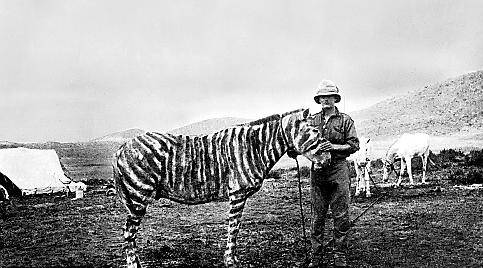Masters of disguise
Reporter: JANICE BARKER
Date published: 16 March 2010

A pony camouflaged as a zebra during the First World War. The disguise enabled an army scout’s pony to be tethered in the open in German East Africa where zebra were common.
Find out how to get lost in the background at the Imperial War Museum North’s family-friendly exhibition about camouflage.
Visitors can discover how to hide a fleet of battleships and find out why the armed forces would paint a jeep pink.
They will be greeted by the sand coloured Cold War Russian tank, captured by British Forces in Iraq in 2003, outside the museum.
The small interactive exhibition marks 95 years since camouflage was first used in warfare by combatants during the First World War.
Revealing the principles of disguise and deception, tactile activities show how camouflage has developed throughout the 20th century and explore the art of obstruction and illusion on land, in the air and at sea.
Families can also get hands on and feel the textures of trickery, and follow a special camouflage trail to discover a host of objects large and small, including a First World War trench mortar.
Then they can get hands to try out some camouflage for real.
Jim Forrester, Imperial War Museum North director, said: “Ninety five years ago camouflage was a brilliant military invention — now it has become very much part of popular culture.
“This family-friendly display is a fun way for all the family to unearth the true secrets of disguise and deception.”
The exhibition runs from March 27 to September 12.
Fascinating factfile of ‘an unchivalrous’ technique
1 The widespread use of camouflage only began during the First World War. At first, some British soldiers thought it was unchivalrous.
2 A French designer named Falke was shot in the hand because he got out of a trench to put the finishing touch to a camouflage.
3 During the First World War, the Allies built fake trees for soldiers to hide inside and spy on German positions.
4 In the Second World War, a camouflage adviser recommended that men of the Home Guard in the countryside should try smearing cow-dung on their faces to make them less visible.
5 During the Second World War, German soldiers were asked to camouflage their own vehicles. Often they would simply throw pots of paint at their tanks.
6 The pattern used by the US Army on some uniforms in the Second World War was called “frog”, copying the natural world.
7 In the Second World War, the British made mats cut and painted to look like the shape and shadow of a tank to trick enemy aircraft into thinking there were more British tanks than there actually were.
8 In 1944, a massive camouflage operation successfully hid two million troops preparing to take part in the D-Day landings.
9 As ships were too large to hide at sea, bold patterns in bright colours were painted on ships to make it difficult for enemy submarine commanders to work out their size, shape and speed. It was called Dazzle.
10 After the Vietnam War, large numbers of spare army camouflage uniforms were sold in shops. Young people now wear it to stand out, rather than to hide.
Most Viewed News Stories
- 1Council chopped down trees 10 months ago, but the cuttings still remain
- 2Dynamic rescue team duo pledge to raise funds for brave Finn
- 3Oldham man caged after 150 wraps of crack cocaine were found during house search
- 4Royton friends set to take on 90-mile charity walk in memory of popular local dad
- 5Police probe follows Chadderton pepper-spraying incident




